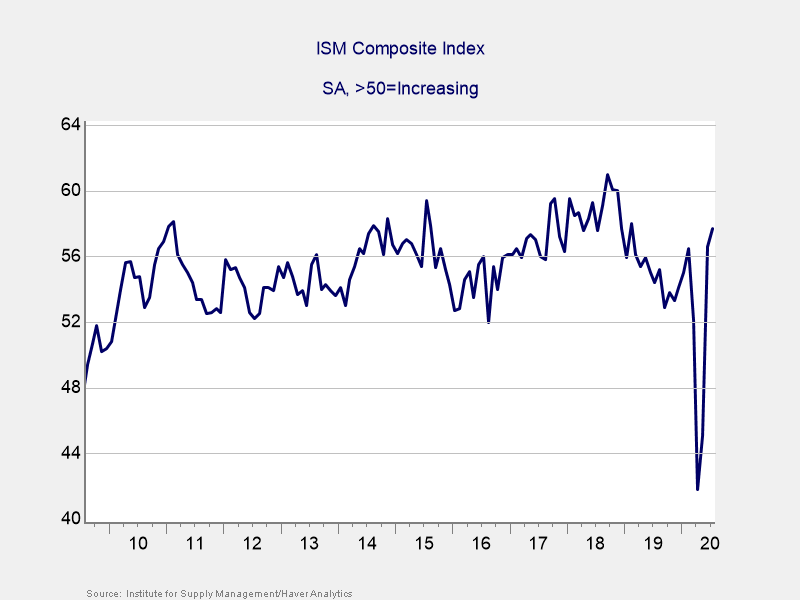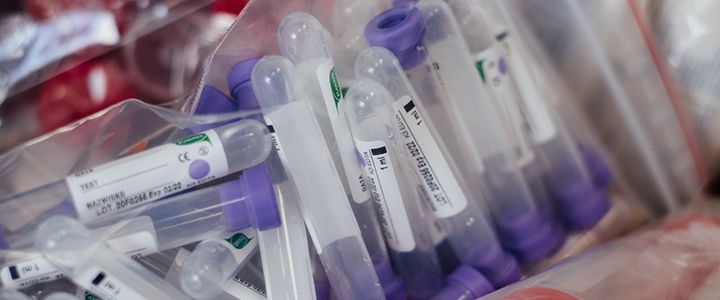A positive month for markets
August was another strong month for financial markets. The S&P 500 and Nasdaq Composite both set all-time highs, gaining 7.19 percent and 9.70 percent, respectively. The Dow Jones Industrial Average gained 7.92 percent.
These strong results were supported by better-than-expected fundamentals during the month. According to Bloomberg Intelligence, with 91 percent of companies having reported, the blended earnings decline for the S&P 500 was 32.8 percent in the second quarter. Companies largely came in above expectations during the quarter, with 82 percent of reporting companies beating earnings estimates.
Technical factors were also supportive. All three major U.S. equity indices spent the month above their respective 200-day moving averages. This marks two straight months with all three indices finishing above trend.
The story was much the same internationally. The MSCI EAFE Index returned 5.14 percent during the month. The MSCI Emerging Markets Index returned 2.24 percent. Technicals for emerging and developed markets were supportive in August, and both indices spent the month above trend.
Fixed income markets had a challenging month, as rising long-term interest rates weighed on returns. The 10-year Treasury yield started the month at 0.56 percent and rose to 0.72 percent by the end of August. The Bloomberg Barclays U.S. Aggregate Bond Index lost 0.81 percent. High-yield bonds had a more encouraging month. The Bloomberg Barclays U.S. Corporate High Yield Index gained 0.95 percent in August. High-yield spreads continued to narrow, as investors showed a growing appetite to accept lower yields for relatively riskier fixed income assets.
Public health picture improves
We saw continued progress in combating the spread of the coronavirus in August. On a national level, the daily spread rate was roughly 0.7 percent at month-end. This is a significant improvement compared with mid-July, when the spread rate spiked above 2 percent.
Testing disappointed during the month, though. The average number of daily new tests fell by more than 9 percent in the final week of August compared with the last week of July. The positive test ratio averaged 6.6 percent, which is higher than the World Health Organization’s recommended 5 percent level.
While there was some encouraging progress made on the public health front during the month, there is still more work to be done. Looking forward, all eyes will be on efforts to reopen schools, as this represents a clear health risk.
Economic recovery slowing but still growing
The economy continued to rebound in August, but the recovery may be slowing. Retail sales and personal spending increased during the month but at a slower rate than in May and June. Continued challenges for the labor market and concerns about the pace of economic growth weighed on consumers’ minds early in the month. There were signs that confidence started to improve by month-end, however.
Despite the mixed results for consumer confidence and spending, businesses performed well. Business confidence, as measured by the Institute for Supply Management (ISM) Composite index, increased in July to its highest level in more than a year, as you can see in Figure 1.
Figure 1. ISM Composite Index, 2009–Present

Businesses also showed they were willing and able to spend during the month. July’s durable goods orders report blew past expectations, rising by 11.2 percent against calls for a 4.8 percent increase. Core durable goods sales, which strip out the impact of volatile transportation orders, also grew by more than expected. These strong results, combined with higher-than-expected levels of manufacturing output and new home construction, give a reason to hope for strong business investment during the quarter.
Risks remain, but outlook is modestly optimistic
While the path forward most likely points to continued growth, the hopes of a continued recovery rely largely on consumer improvements. There are also external risks that should be monitored, including worsening U.S.-China trade relations, social unrest, and the upcoming elections. A well-diversified portfolio that matches investor timelines and goals is the best path forward for most. If concerns remain, we are available to discuss and help as we progress through these uncertain times.
All information according to Bloomberg, unless stated otherwise.
Disclosure: Certain sections of this commentary contain forward-looking statements based on our reasonable expectations, estimates, projections, and assumptions. Forward-looking statements are not guarantees of future performance and involve certain risks and uncertainties, which are difficult to predict. Past performance is not indicative of future results. Diversification does not assure a profit or protect against loss in declining markets. All indices are unmanaged and investors cannot invest directly into an index. The Dow Jones Industrial Average is a price-weighted average of 30 actively traded blue-chip stocks. The S&P 500 Index is a broad-based measurement of changes in stock market conditions based on the average performance of 500 widely held common stocks. The Nasdaq Composite Index measures the performance of all issues listed in the Nasdaq Stock Market, except for rights, warrants, units, and convertible debentures. The MSCI EAFE Index is a float-adjusted market capitalization index designed to measure developed market equity performance, excluding the U.S. and Canada. The MSCI Emerging Markets Index is a market capitalization-weighted index composed of companies representative of the market structure of 26 emerging market countries in Europe, Latin America, and the Pacific Basin. It excludes closed markets and those shares in otherwise free markets that are not purchasable by foreigners. The Bloomberg Barclays Aggregate Bond Index is an unmanaged market value-weighted index representing securities that are SEC-registered, taxable, and dollar-denominated. It covers the U.S. investment-grade fixed-rate bond market, with index components for a combination of the Bloomberg Barclays government and corporate securities, mortgage-backed pass-through securities, and asset-backed securities. The Bloomberg Barclays U.S. Corporate High Yield Index covers the USD-denominated, non-investment-grade, fixed-rate, taxable corporate bond market. Securities are classified as high-yield if the middle rating of Moody’s, Fitch, and S&P is Ba1/BB+/BB+ or below. Authored by Brad McMillan, CFA®, CAIA, MAI, managing principal, chief investment officer, and Sam Millette, senior investment research analyst, at Commonwealth Financial Network®. © 2020 Commonwealth Financial Network®





